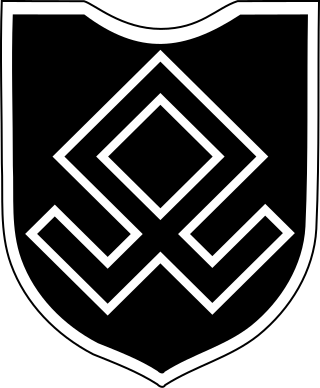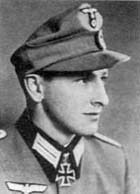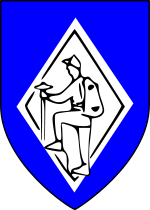
The 334th Infantry Division was a German Army infantry division in World War II. Originally formed in November 1942, it surrendered to the Allies at the conclusion of the Tunisian Campaign in May 1943. The division was reconstituted on 3 June 1943 in France within the 1st Army, with the staff of the 80th Infantry Division as well as remnants of the old division and replacement units. It spent the remainder of the war serving on the Italian Front.

The 3rd Mountain Division was a formation of the German Wehrmacht during World War II. It was created from the Austrian Army's 5th and 7th Divisions following the Anschluss in 1938.
The 4th Mountain Division was a mountain infantry division of the Heer, the army of the Wehrmacht of Nazi Germany during World War II. The division was active between October 1940 and May 1940 and participated in the Balkans campaign as well as on the Eastern Front.

The 5th Mountain Division was a formation of the German Wehrmacht during World War II. It was established in the Wehrkreis XVIII in October 1940, out of units taken from the 1st Mountain Division and the 10th Infantry Division. The unit surrendered to the U.S. Army near Turin in May 1945.

The 6th Mountain Division was a German army Division of World War II. It was established in June 1940, and was deployed to France for occupation duties. In December it was relocated to Poland, where it remained until the spring of 1941. Having formed XVIII Mountain Corps with the 5th Mountain Division, it then took part in Operation Marita, the invasion of Greece during the Balkans Campaign. In September it was relocated to northern Finland, where it operated in Lapland. From July 1942 onward it was part of the 20th Mountain Army along the Arctic coast. It withdrew into Norway when the Germans evacuated Finland in late 1944, and surrendered to the British at the end of the war in 1945.

Gebirgsjäger are the light infantry part of the alpine or mountain troops (Gebirgstruppe) of Germany, Austria, and Switzerland. The word Jäger is a characteristic term used for light infantry in German speaking countries.

The 7th SS Volunteer Mountain Division "Prinz Eugen", initially named the SS-Volunteer Division Prinz Eugen, was a mountain infantry division of the Waffen-SS, an armed branch of the German Nazi Party that served alongside but was never formally part of the Wehrmacht during World War II. At the post-war Nuremberg trials, the Waffen-SS was declared to be a criminal organisation due to its major involvement in war crimes and crimes against humanity. From 1942 to 1945, the division fought a counter-insurgency campaign against communist-led Yugoslav Partisan resistance forces in occupied Yugoslavia. It was formed in 1941 from both Reich Germans and Volksdeutsche – ethnic German volunteers and conscripts from the Banat, Independent State of Croatia, Hungary and Romania. The division surrendered on 11 May 1945 to Yugoslav Partisan forces, with thousands of stragglers surrendering by the 15th near the Austrian border.

Army Group E was a German Army Group active during World War II.

Michael Pössinger was a German bobsledder who competed in the early 1950s. He won a complete set of medals in the four-man event at the FIBT World Championships with a gold in 1951, a silver in 1954, and a bronze in 1953. Pössinger finished sixth in the four-man event at the 1956 Winter Olympics in Cortina d'Ampezzo.

Hans Kreysing was a German general who commanded the 3rd Mountain Division and the 8th Army. He was a recipient of the Knight's Cross of the Iron Cross with Oak Leaves and Swords.

Karl Hubert Lanz was a German general during the Second World War, in which he led units in the Eastern Front and in the Balkans. After the war, he was tried for war crimes and convicted in the Southeast Case, specifically for several atrocities committed by units under his command in the Balkans. Released in 1951, he joined the liberal Free Democratic Party and served as its adviser on military and security issues.

The 24th Waffen Mountain Division of the SS Karstjäger was a German mountain infantry division of the Waffen-SS, the armed wing of the German Nazi Party that served alongside but was never formally part of the Wehrmacht during World War II. At the post-war Nuremberg trials, the Waffen-SS was declared to be a criminal organisation due to its major involvement in war crimes and crimes against humanity. Named Karstjäger, the formation was one of the 38 divisions fielded by the Waffen-SS. Formed on 18 July 1944 from the SS Volunteer Karstwehr Battalion, its nominal strength was never more than theoretical and the division was soon reduced to the Waffen Mountain Brigade of the SS. Throughout its existence as a battalion, division and brigade, it was primarily involved in fighting partisans in the Karst Plateau on the frontiers of Yugoslavia, Italy, and Austria; the mountainous terrain required specialised mountain troops and equipment.

The 7th Mountain Division was formed through the redesignation of 99th Light Infantry Division, which had fought on the southern sector of the Eastern Front until being withdrawn to Germany in October 1941. In 1942, it was sent to Finland and remained there until the Finnish withdrawal from the war. The Division retreated into Norway where it remained until the end of the War.

The 8th Mountain Division was formed on 27 February 1945 by the redesignation of the 157th Mountain Division, which itself had been formed from the 157th Infantry Division in September 1944, and which had participated in operations against the maquis of Vercors. The division was stationed in France until the Italian surrender when it then moved to Italy taking 5,772 prisoners in two days during the disarmament of the Italian Army. The division remained in Italy for the rest of the war and surrendered to the Americans in April, 1945.

104th Jäger Division was an infantry division of the Germany Army in World War II. It was formed in April 1943, by the redesignation of the 704th Infantry Division, which was itself formed in April 1941. The division served in German-occupied Yugoslavia in May 1941 where it took part in anti-partisan and security operations in the Independent State of Croatia. In April 1943, it was reorganized and redesignated the 104th Jäger Division and took part in the Battle of the Sutjeska in June 1943. Following the Italian surrender, elements from the division took part in the murder of thousands of Italians from the 33 Infantry Division Acqui in September 1943, on the Greek island of Cefalonia in one of the largest-scale German atrocities to be committed by German Army troops instead of the Waffen SS.

114th Jäger Division was a light infantry division of the German Army in World War II. It was formed in April 1943, following the reorganization and redesignation of the 714th Infantry Division. The 714th Division had been formed in May 1941, and transferred to Yugoslavia to conduct anti-partisan and Internal security operations. It was involved in Operation Delphin which was an anti-partisan operation in Croatia that took place between 15 November and 1 December 1943. The objective of the mission was to destroy the Partisan elements on the Dalmatian islands off central Dalmatia.

Hartwig von Ludwiger was a German general in the Wehrmacht of Nazi Germany during World War II. Ludwiger was responsible for numerous atrocities committed throughout the Balkans. After the war, he was charged with war crimes in Yugoslavia, convicted, and executed.
Karl Hans Maximilian von Le Suire was a German general during World War II who commanded the XXXXIX Mountain Corps. He was responsible for the Massacre of Kalavryta, in Greece.

Helmuth Raithel was a German officer who held the rank of SS-Standartenführer (colonel) in the Waffen-SS during World War II. While still at school, Raithel was swept up in the excitement of the Munich Beer Hall Putsch of 9 November 1923 led by Adolf Hitler, and was subsequently awarded the coveted Blood Order, even though he was not a member of the Nazi Party. He joined the Reichswehr in 1926. After World War II broke out, he fought in the invasion of Greece in summer 1941, then against the Soviet Red Army in northern Finland before transferring to the Waffen-SS in 1943.

Walter Stettner Ritter von Grabenhofen was a German general in the Wehrmacht during World War II and a recipient of the Knight's Cross of the Iron Cross. In October 1944 he went missing in action on Mount Avala, near Belgrade in Serbia.


![Division's commander, General Walter von Grabenhofen [de], in Yugoslavia, June 1943 Bundesarchiv Bild 183-J14577, Montenegro, Gebirgsjager-Einsatz gegen Partisanen.jpg](http://upload.wikimedia.org/wikipedia/commons/thumb/3/30/Bundesarchiv_Bild_183-J14577%2C_Montenegro%2C_Gebirgsj%C3%A4ger-Einsatz_gegen_Partisanen.jpg/170px-Bundesarchiv_Bild_183-J14577%2C_Montenegro%2C_Gebirgsj%C3%A4ger-Einsatz_gegen_Partisanen.jpg)

















